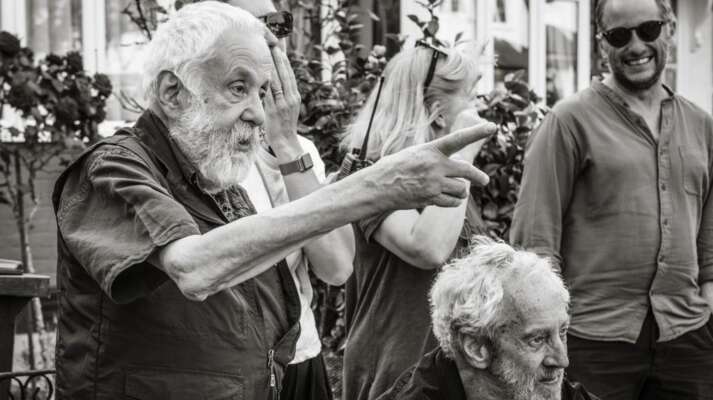In Mark Pellington’s THE LAST WORD, Shirley MacLaine plays Harriet Lauler, a smart, successful, and stubborn woman who has climbed to the top by her unwavering confidence in her ability to handle every situation on her own. In the twilight of her life, she even decides to orchestrate how people remember her by hiring a local obituary writer, Anne Sherman (Amanda Seyfried), to compose a fitting memorial. Unfortunately, she has so depended on self-reliance that there is no one about to put in a good word for her. Joining forces with Anne, Harriet sets out to rewrite the last chapter of her life, an adventure that teaches her a brand new trick––how to rely on others. “Each is learning from the other,” explains MacLaine, “so it’s the journey the two women take together.” Along the way, Harriet adds a third member to the group, Brenda (Ann’Jewel Lee), a 9-year-old whippersnapper whom the older woman wishes to mentor. But as their friendship opens up, Brenda ends up teaching Harriet a thing or two as well. However different they are, these three women find a way to unite, discovering in the process how each needs the others to become the person she was always meant to be. As Harriet learns what makes her experience worth writing about, she pushes her friends to do the same. “She’s showing Anne and Brenda—and herself—what kind of life that she wants to lead,” notes Pellington. “She is encouraging them to figure that out for themselves. Open yourself up. Don’t be afraid to fail. … She takes what could be sentimental, greeting-card life lessons and makes them completely human and grounded.” In a tribute to the moving message at the heart of THE LAST WORD, we remember other funny and heartwarming films in which women unite, finding their individual destiny through a common goal.
9 to 5 | Workin’ It

In Colin Higgins’ workplace comedy,
9 to 5, three female leads––Jane Fonda, Lily Tomlin, and newcomer Dolly Parton––unite in their hatred of their “sexist, egotistical, lying, hypocritical” male boss (played by Dabney Coleman), a man each woman joyfully fantasizes about killing. The original version, however, went much further than fantasy. Screenwriter Patricia Resnick tells
Rolling Stone, “I had written a very dark comedy in which the secretaries actually tried to kill the boss, although they tried to kill him in sort of funny ways.” For producer Fonda, the key to both versions was to make the story funny. Fonda wanted her company IPC––which produced
9 to 5––to use popcorn entertainment to make serious issues easy for the public to digest. Just as IPC turned nuclear power into a suspense thriller with its 1979
The China Syndrome,
9 to 5 would address workplace discrimination with farce and fantasy. "It remains a 'labor film', but I hope of a new kind, different from
The Grapes of Wrath or
Salt of the Earth," explains Fonda. "We took out a lot of stuff that was filmed… I'm just super-sensitive to anything that smacks of the soapbox or lecturing the audience.” The idea for the film came to Fonda after talking to various members of a Boston organization named 9to5, National Association of Working Women. “They had some great stories,” remembers Fonda. “And I've always been attracted to those 1940s films with three female stars.” Screenwriter Resnick not only wrote for three stars, but for the actual three stars who appear in the film. “I had Dolly, Lily and Jane in my head the whole time,” Resnick tells
Rolling Stone. Parton not only made her feature film debut, but also provided the Oscar-nominated song, “9 to 5.” While many, mostly male critics at the time lightly praised the film as an unassuming comedy, audiences came in droves, making it the second highest grossing film of 1980. And its lasting political significance quickly became apparent to people who worked in the field. “We had to argue that women’s work was plagued by discrimination. The movie put an end to that debate,” notes labor organizer Karen Nussbaum about the film’s impact. “Now the debate could shift to what we should do about it.” While its politics still resonate today, so does its humor. “People like to say what a giant feminist document it is, but it’s a funny, funny movie. It gave you a message in a charming, comic way,” film scholar Jeanine Basinger tells
Closer Magazine.
Thelma & Louise | Two for the Road

Ridley Scott’s 1991
Thelma & Louise turns the classic buddy film inside out by changing the gender of its two protagonists. While in hindsight the concept of making a female buddy film might seem obvious, for screenwriter Callie Khouri, the idea hit her like a truck. “Out of nowhere I thought, ‘Two women go on a crime spree’,” Khouri tells
Vanity Fair. “I saw, in a flash, where those women started and where they ended up. Through a series of accidents, they would go from being invisible to being too big for their world to contain, because they'd stopped cooperating with things that were absolutely preposterous, and just became themselves.” Unfortunately it was idea that very few male producers seemed able to comprehend. Khouri and her producer, Amanda Temple, shopped the script around Hollywood, hoping to raise enough money to make a low-budget, documentary-style thriller. Their efforts, however, were mostly greeted with snide, patronizing, and sometimes obscene refusals. Eventually they connected with Ridley Scott, who in addition to directing big-budget commercials and action films, ran a production company. “I saw what was unique about it immediately,” Scott remembers to
Vanity Fair. “Women tended to get parts as somebody's girlfriend; this was about no one else but them.” Initially as the film’s producer, Scott attached Jodie Foster and Michelle Pfeiffer to lead and started looking for a director. When the production stalled, Foster and Pfeiffer dropped out, and other female pairs, including Goldie Hawn and Meryl Streep, stepped up. Eventually, after Scott realized that he should direct, he narrowed his leading ladies down to Davis and Sarandon. In the film, Thelma (Geena Davis), who is married to an overbearing lout, and Louise (Susan Sarandon), whose boyfriend won’t take the relationship seriously, depart for a weekend of female fun. But their brief holiday is cut short when an assault in a parking lot forces the two to flee the law in an adventure that quickly turns from crime spree to journey of no return. The film exploded in theaters, igniting debates across the political spectrum.
TIME Magazineput it on its cover with the title, “Why
Thelma & Louise Strikes a Nerve.” In
U.S. News & World Report, conservative pundit John Leo denigrated it for its “toxic feminism.” Some feminists bemoaned its tragic ending. For all, it completely changed the conversation about female empowerment. In
Sight and Sound, Manohla Dargis wrote that the film “created a paradigm of female friendship produced out of their willful refusal of the male world and its laws. No matter where their trip finally ends, Thelma and Louise have reinvented sisterhood for the American screen.” Nominated for six Academy Awards, including Best Actress nods for both Davis and Sarandon, and a Best Director nom for Scott, it won a Best Original Screenplay Oscar for Khouri. On accepting her award, Khouri highlighted that however tragic the film’s final scene is, its very existence marks a success for all women: “For everybody that wanted to see a happy ending for Thelma and Louise, to me this is it.”

Calendar Girls | Baring Souls
Nigel Cole’s 2003 comedy Calendar Girlsbrought to the screen a hilarious and heartwarming real-life example of women coming together. The film’s inspiration came from an episode in 1988 when women in an English village turned tragedy into triumph by taking off their clothes. After Angela Baker's husband died from non-Hodgkin's lymphoma, her friends at the Rylstone Women’s Institute rallied around her to show support by agreeing to make a calendar. The husband of the woman who would go on to become Miss January, Terry Logan, tastefully photographed the women in varying degrees of undress. Hoping to raise enough money for a new sofa for a cancer clinic, the calendar quickly became an international sensation, earning more than a half million dollars for the UK charity, Leukaemia & Lymphoma Research, and putting the women on American talk shows from Rosie O’Donnell to Jay Leno. Seeing the filmic possibilities, especially in light of The Full Monty’s success a few years earlier, Disney acquired life rights from six of the original women. With more than a little poetic license, screenwriters Tim Firth and Juliette Towhidi transformed the calendar girls’ stories into an inspirational comedy of mature women fighting for their right to be seen. Casting some of Britain’s finest actresses, including Helen Mirren and Julie Waters, proved an unexpected challenge for the director. “Many of the actresses had never taken off their clothes on screen or in public,” explains Cole. “Many are considerably older than actresses who are prepared to take off their clothes on film.” But for Mirren, the film ultimately is less about nude women than the naked truth. "I think it's about force of personality, about character,” Mirren tells Film4. “And the truth of women is that they are strong-willed, funny, full of character, full of energy.” Indeed for many critics, the women––both the actresses and the characters––in coming together to help each other by stripping for the calendar turn the male-centric narrative of getting women to show a little skin upside down. In The Denver Post, Lisa Kennedy writes “claiming and proclaiming their bodies for themselves -- and by extension, others -- remains a positive gesture. And the movie industry resolving to embrace a variety of body images wouldn't be the worst way to herald a new year in pictures.”
The Help | Cleaning Up History

Tate Taylor’s 2011
The Help, an adaptation of Kathryn Stockett’s bestselling novel, brings together a stellar cast to capture a historical moment when African-American maids in the South bonded together. For Stockett, it was a more recent event, the bombing of the World Trade Center Towers, which inspired her. “It can be really powerful to write something when you're sad,” Stockett tells
The Guardian. “I've always felt that Aibileen [one of the maids] had this really deep sadness that I would never understand, being a privileged, spoilt little white girl. Maybe when 9/11 occurred and I was in downtown New York, maybe that's the closest I'll ever be to understanding that sadness.” Her childhood friend, Tate Taylor, acquired the rights to the book, long before it was published. While Dreamworks eventually produced the film, Taylor stayed on, adapting and directing the movie. He also convinced another friend, Octavia Spencer, whom he’d befriended when they worked together as production assistants on the 1996
A Time To Kill, to join the cast. In the film, Skeeter Phelan (Emma Stone) returns home to Jackson, Mississippi, from college, hoping to launch her journalism career by penning an exposé about the secret lives of “the help,” that being the African-American maids who run the households of Skeeter’s wealthy white neighbors. Going behind the backs of friends and family––played by the likes of Allison Janney, Jessica Chastain, and Bryce Dallas Howard––Skeeter slowly convinces local maids, like Aibileen (Viola Davis) and Minny (Spencer), to disclose the terrible truths that lay behind the faux Georgian fronts of these fine Southern homes. “In the course of this project, which involves the women meeting on the sly to tell their personal stories, a bond is forged,” notes
USA Today’s Claudia Puig. “Their sisterhood evolves slowly and naturally.” For many of the African-American actresses that bond goes beyond the characters to the women they represent. In accepting the Screen Actors Guild Award for Best Supporting Actress, Spencer acknowledged the women who “represented our mothers and grandmothers. It was their courage and them facing the challenges that they faced everyday and living their life with dignity and grace. By honoring me you honor them.” The film went on to be nominated for four Academy Awards with Octavia Spencer winning for Best Performance by an Actress in a Supporting Role.
The Devil Wears Prada | Costume Drama

While the catty relationships of women fighting in the fickle world of a fashion magazine might not seem to demonstrate that sisterhood is powerful, the two leads in David Frankel’s 2006
The Devil Wears Prada forge a real, even poignant relationship. The attraction of the book initially, however, was not one of friendship, but of fiendishness. Before Lauren Weisberger had even finished her tell-all novel,
The Devil Wears Prada, studios were bidding on the movie rights. Fox’s Carla Hecken, who wanted the book for the title character alone, tells
Variety: "I thought Miranda Priestly was one of the greatest villains ever.” Loosely based on
Vogue’s legendary editor, Anna Wintour, for whom Weisberger had briefly worked, the novel recounts the rough-and-tumble experience of a young woman as the personal assistant to a high-powered, impossibly demanding fashion editrix. Its hilarious series of escapades, however, didn’t quite add up to a movie plot. Director Frankel, who previously covered this world as a director for the HBO series
Sex and the City, worked with writer Aline Brosh McKenna to create a screenplay worthy of the one actor they wanted to play Miranda––Meryl Streep. “We had talked about Meryl a little bit, but I dare not allow myself to dream,” McKenna tells
Variety. Streep agreed to appear if they doubled their offer and seriously considered several script suggestions. With the film being seen through the eyes of the young assistant, Andy Sachs (Anne Hathaway), with Emily Blunt playing her co-worker/competitor, Streep wanted to be sure that Miranda didn’t come off as simply a villainous caricature of an ambitious woman. Streep pushed to expand two scenes that would illustrate her complex relationship with the women who worked for her. In one, Miranda tartly demonstrates the power of fashion by tracing the history of a single color, the cerulean blue of her assistant’s sweater, from the runway show that introduced it to the bargain basement boutique frequented by cost-cutting shoppers like Andy. In the other, perhaps more significant moment, Streep drops her façade and allows Andy to see her as a just another woman––undressed, without make up, and frightened for her future. “She is without her armor,” Streep explains in
Vanity Fair. “Just to see that face without its protective glaze [is] to glimpse the woman in the businesswoman.” Streep explains the importance of this scene to
Indiewire when she notes, “It’s a big surprise to everybody, when movies are about women and not about the boyfriends or men in their lives or who loves them.” While Miranda is certainly the boss everyone loves to hate, many critics suggest that Steep and Hathaway also made her the woman people need to understand. “What if this were a movie about a man—a young man apprenticing himself to a hard-boiled older mentor?” asks
Slate’s Dana Stevens. “I can't help but think that the moral compromises required in order to sully the hero's character would be much greater, and that he wouldn't have to apologize for caring about his job.”







